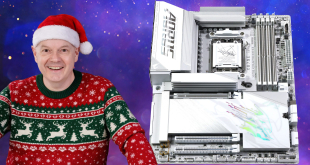It has been an interesting few days testing AMD's RX 6500 XT graphics card. Using the new Navi 24 GPU, fabbed on TSMC's 6nm process, the RX 6500 XT is the lowest-end RDNA 2 desktop product that we have seen so far, targeting a $199 MSRP, or £179.99 for those of us in the UK.
However, after thoroughly testing this card, we can only come away feeling bitterly, bitterly disappointed with what AMD has brought to the market.
That starts with the overall performance. Designed as a 1080p card, across the twelve games we tested, the RX 6500 XT proved slower than the GTX 1650 Super and only fractionally (less than 4%) faster than the RX 5500 XT 4GB and RX 580 8GB – the results being so close we would call them functionally the same. That alone is pretty shocking, that 1080p gaming performance hasn't advanced since the RX 580 from 2017. But it gets worse.
The thing is, that data comes when testing the card on a PCIe 4.0 interface. The 6500 XT is a PCIe 4.0 card, so that testing is valid. However, as a $199 1080p graphics card, I would say the majority of people who would buy such a product are likely on a PCIe 3.0 platform. And given the RX 6500 XT features just four PCIe lanes, gaming performance is significantly reduced when tested with PCIe 3.0.
On average, the RX 6500 XT is 17% slower on PCIe 3.0 than it is on PCIe 4.0, but games including Forza Horizon 5, Cyberpunk 2077, Horizon Zero Dawn and Resident Village all saw performance drops of over 20%. In fact, Hitman 3 was the only game we tested where changing the PCIe bandwidth to Gen3 made next to no difference.
The consequences of this are dire. Such a crippled PCIe interface means, for those with a PCIe 3.0 platform, that the GTX 1060 6GB is actually faster on average than the RX 6500 XT, while the RX 570 offers equivalent average frame rates, but often provided more stable 1% lows. In other words, on a PCIe 3.0 interface, the RX 6500 XT is worse than AMD's $169/£165 product from 2017.
It might sound surprising off the back of that, but I actually think that elements of RX 6500 XT GPU – the 16 compute units, 1024 stream processors and super-high clock speeds – are actually OK. Not a step forward or particularly good, but OK. With that in mind, I would suggest it is a number of very questionable decisions AMD made which really rendered this card dead on arrival.
Of course, we touched on the PCIe interface issue, but 4GB of VRAM in 2022 is also completely unacceptable, along with an exceptionally narrow 64-bit memory interface. I have never seen a desktop ‘gaming' card use such a narrow memory bus, and certainly not at this price-point.
On the topic of the VRAM capacity however, this deserves some further attention as I do believe AMD is really insulting the enthusiast audience. That's because the issues with the PCIe interface and VRAM capacity are very much linked – if the RX 6500 XT had 8GB VRAM, the GPU wouldn't have to offload as much data back and forth across the PCIe interface, which is what hurts performance as a result of the 4-lane limitation (and that is exacerbated on PCIe 3.0).
But despite that, AMD is somehow claiming that 4GB of VRAM is ‘optimized' and is a ‘really nice frame buffer size'. It is utter nonsense and completely dishonest, not to mention exceedingly hypocritical considering AMD itself wrote, in June 2020, that ‘4GB of VRAM… is evidently not enough for todays games.' In fact, as I went to access the blog post today where those words were written, we found that post is no longer live on the AMD website – a truly terrible look for AMD on the launch day of the RX 6500 XT.
All we can say in closing is – please don't buy this graphics card. If you know anyone thinking about buying it, tell them to wait, or get something else. At the expected retail prices once the initial batch of MSRP cards has sold out, consumers would be getting both a cheaper and overall better product by purchasing the six year-old RX 480 than AMD's newest graphics card, something which can only be described as an utter travesty, and frankly, an insult to gamers.
AMD told us RX 6500 XT cards will be available at the SEP from Overclockers UK, eBuyer and Scan. We have been told by other sources to expect significantly higher prices once the initial batch is sold out.
Discuss on our Facebook page HERE.
Pros
- Very high clock speed.
- Low power draw (but still requires 6-pin connector).
Cons
- Performance on PCIe 4.0 is no better than the RX 580, GTX 1650 Super or RX 5500 XT.
- Performance on PCIe 3.0 is worse than the GTX 1060 and RX 570.
- Only 4GB VRAM.
- 64-bit memory interface.
- Less efficient than GTX 1650 Super.
- Only two video outputs.
- No H.264 or H.265 video encode.
KitGuru says: Do NOT buy the AMD RX 6500 XT.
 KitGuru KitGuru.net – Tech News | Hardware News | Hardware Reviews | IOS | Mobile | Gaming | Graphics Cards
KitGuru KitGuru.net – Tech News | Hardware News | Hardware Reviews | IOS | Mobile | Gaming | Graphics Cards





